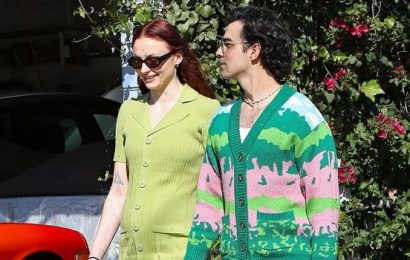Our December plans might be looking more uncertain with each passing moment, but everywhere we look, sequins and snowflake prints assure us we’re still firmly in ‘festive dressing’ mode.
Tartan PJs, novelty knits, twinning with our Christmas trees in red, green and gold, velvet co-ords, high-shine metallic jumpsuits… however you choose to interpret the season’s ‘sartorial uniform’ (elegant or OTT?), fashion is as much a part of the fabric of Christmas as gingerbread lattes and Mariah Carey songs.
Since Christmas is (typically) one of the most social times of year, chatty slogan jumpers and bold partywear adorned with sequins, glitter and velvet invite people to notice us.
‘People want to feel glamorous and these styles help portray an image of luxury, even if the items bought are not in themselves particularly expensive,’ explains Chloe Collins, head of apparel at GlobalData. ‘As it is a special time of year, people want to show they are making an effort.’
People in search of much-needed cheer launched themselves into the Christmas spirit weeks ago, decorating trees in November and adhering to December dress codes throughout autumn (see the Duchess of Cambridge’s commitment to red and sparkly green outfits).
Behavioural psychologist Professor Carolyn Mair, author of The Psychology of Fashion, tells Metro.co.uk: ‘This idea of being unified and embracing the festive season is really important, especially this year.
‘We’ve felt the feeling of being in the festive period much earlier than usual. There’s a lot of fear around another lockdown and we’re making the most of every day – people are really living in the now.’
This might explain why I’ve spotted several people wearing reindeer headbands in the daytime, heading to the pub or dropping the kids to school. Why not? Festive fashion may be just the mood-enhancer we’re looking for right now.
How festive dressing can boost your mood
The concept of mood-enhancing fashion, where certain colours and fabrics help release feel-good hormones, is nothing new (Professor Karen Pine has done extensive research into how people’s emotions and confidence levels correlate with the clothing they happen to be wearing), but became more of a talking point in 2021 as we emerged from lockdown living and 24/7 loungewear.
Known as dopamine dressing, this desire for bolder, louder, happier clothes is set to continue into the new year. According to Pinterest, dopamine dressing is a key trend for 2022, driven by all age groups and genders.
Australian designer/artist Rachel Burke is known for ‘dopamine-boosting’ creations, like her bespoke tinsel garments (there’s a waitlist through 2024), which encourage the wearer to shimmy and shake because of how the material moves.
Burke has seen an uptick in customer interest for her designs since the pandemic started, which she attributes in part to the sense that life’s too short not to have a bit of fun with what we’re wearing.
‘People want to uplift and empower themselves to be joyful when things are so grim,’ she says. ‘It’s interesting that people choose to celebrate with their body in that way, almost like they are becoming a decoration themselves.’
Why we choose sequins and velvet for Christmas
People pushing the fashion envelope a bit further this festive season – by wearing sequins in the daytime, for example – is something Professor Mair has also observed.
She likens December style to ‘conscious dressing,’ where we think about the reaction we want from our clothes, as opposed to throwing on whatever item we see first.
Slipping into sequins is the sartorial equivalent of a conversational ice breaker. They invite people to approach and admire the fabric reflecting light in different ways.
‘Sequins attract attention, even if the wearer is seated,’ explains Professor Mair. ‘We wear sequins because we want to be noticed. We want to be interacting with other people, we want to be part of the zeitgeist, we want to be part of the festive season.’
Velvet – another popular fabric this time of year – is connected to sumptuousness and comfort. It begs to be stroked.
‘We associate items that are very soft to touch with this feeling of hugging and wanting to be hugged. Touch is a super important sensation, which we know from babies,’ she says.
Dressing for community… and unity
Festive dressing isn’t just about finding confidence or turning heads in a certain fabric or silhouette. It’s also about connection, which is one reason Christmas jumpers have become part of the fabric of our cultural identity each December. Matching ones tell the world we’re part of a team (of friends, family members or co-workers).
‘This trend has particularly boomed in recent years, with family dressing in particular gaining popularity,’ says Collins. ‘At a time when family is the main focus, matching outfits allow consumers to demonstrate unity.’
The pandemic taught us we no longer need to leave the house in novelty jumpers or sparkly dresses to connect with others, lift someone’s mood or make a connection rooted in fashion choices. We can Facetime a friend, post a pic on social media or engage with brands and like-minded folk online and get (almost) the same thrill we do IRL.
Can festive dressing ever be sustainable?
Festive season fashion may be fun, but those spangly fabrics are no friend of the planet’s – in fact, Boden recently announced plans to ditch non-biodegradable glitter and sequins over environmental concerns.
In an effort to move away from ‘wear once and retire’ party dresses, secondhand and rental options are becoming increasingly popular, like Ghost x M&S frocks on Hirestreet.
Playful accessories – a Christmas lights necklace, a pair of Snag’s candycane-striped elf tights – can turn an everyday look into a festive one without the need for a whole new outfit.
‘You can have more variety without having to spend the earth on new outfits, especially if purchasing sustainable clothing that actually fits and is affordable is difficult, which is one of the main issues with the fashion industry at present,’ says Snag founder Brie Ried. ‘Your same favourite dress can look totally different with a change of tights.’
Fashion may be capricious, but there is a comfort in knowing those novelty jumpers and spangly separates will never go out of style (we revisit them year after year, like a friendlier ghost of Christmas past).
Some festive outfits become more than clothes we wear. Rachel Burke tells us that customers love their tinsel creations so much, many hang them on the wall like works of art.
The real power of festive dressing? How a red velvet dress, beaded jacket or jumper embroidered with Brussels sprouts can become a powerful tool of association, linked to our favourite memories, places and people.
Do you have a story to share?
Get in touch by emailing [email protected].
Source: Read Full Article









